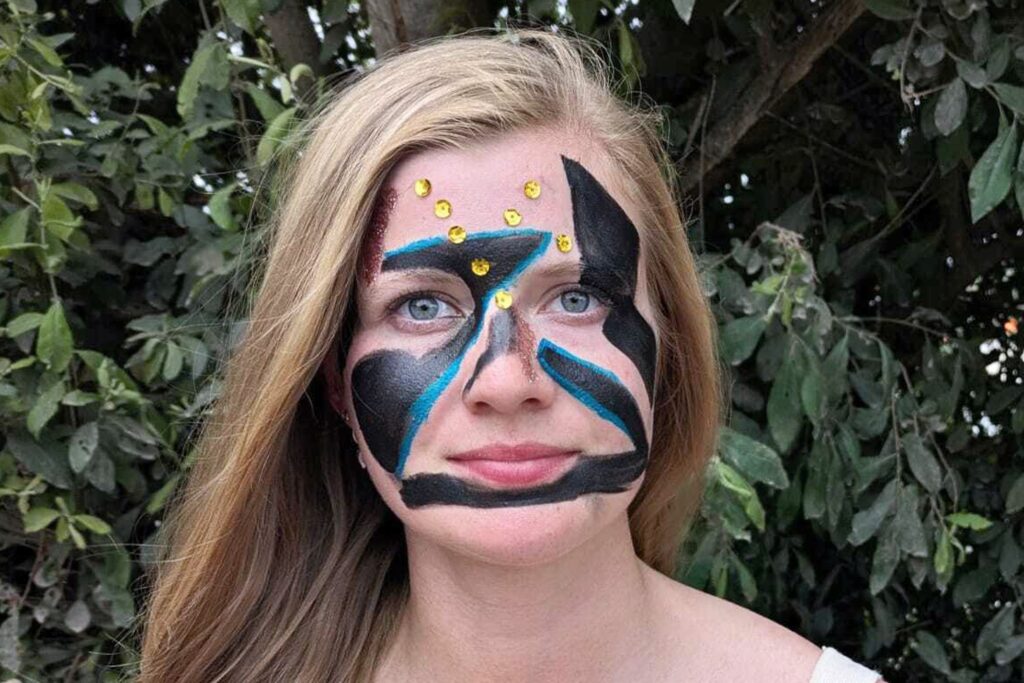Activists and artists held a workshop in the Greenpeace tent at Glastonbury to teach festival-goers how to use “computer vision dazzle” creative, asymmetrical face paint designed to disrupt AI facial-recognition systems.
As thousands of music lovers danced to their favorite bands at this year’s Glastonbury Festival, a different kind of performance was taking place in the Greenpeace tent. Here, activists and artists were teaching festival-goers an unexpected skill: how to make themselves invisible to artificial intelligence while remaining perfectly visible to human eyes.
When Music Meets Digital Resistance
The workshop, which drew curious crowds throughout the festival, introduced attendees to computer vision dazzle—a technique that transforms the face into a canvas of rebellion against algorithmic surveillance. Festival-goers queued up to have bold, asymmetrical patterns painted across their faces, turning the iconic British music festival into an unlikely battleground for digital privacy rights.
“It’s the perfect place to showcase this,” explained one of the workshop facilitators, carefully applying geometric patterns around a young woman’s eyes. “Festivals are about freedom of expression, and what could be more expressive than refusing to let machines track your every move?”
The Art of Digital Invisibility
Computer vision dazzle, also known as CV dazzle or anti-surveillance makeup, represents a fascinating fusion of artistic expression and privacy activism. Originally inspired by the dazzle camouflage patterns used on warships during World War I and II, this modern adaptation uses the same principles to confuse facial recognition algorithms.
The technique works by disrupting the key measurements that AI systems use to identify faces:
Strategic Disruption Methods:
- Bold asymmetrical patterns that break up facial geometry
- Contrasting colors that confuse algorithmic pattern recognition
- Strategic coverage of key facial features like the bridge of the nose
- Geometric shapes that create “anti-face” patterns
At Glastonbury, workshop participants learned to apply these principles while creating looks that were as much about artistic statement as they were about privacy protection. The result was a sea of festival-goers sporting everything from bold zigzag patterns to intricate geometric designs that turned their faces into living art installations.
From Warships to Worthy Farm
The historical connection between naval camouflage and festival face paint might seem unlikely, but the principles are remarkably similar. Just as dazzle camouflage used contrasting colors and angular patterns to confuse enemy targeting systems, CV dazzle employs optical illusions to throw off modern AI algorithms.
“The irony is beautiful,” noted one workshop participant, admiring her newly painted face in a mirror. “We’re using techniques developed for warfare to protect ourselves from corporate surveillance while celebrating peace and music.”
The Artists Behind the Movement
The Glastonbury workshop was led by artists who have been pioneering CV dazzle techniques for years. The movement has been championed by figures like Adam Harvey, who developed the technique as part of his broader exploration of privacy and surveillance, and Jillian Mayer, whose approach often incorporates performance art and social commentary.
These artists have demonstrated that CV dazzle isn’t just about evading detection—it’s about making a powerful statement about privacy rights and the pervasive nature of surveillance in modern society.
Festival-Perfect Rebellion
The festival setting proved ideal for CV dazzle workshops for several reasons:
Natural Fit with Festival Culture:
- Face painting is already a festival tradition
- Attendees are accustomed to bold, experimental looks
- The temporary nature aligns with festival experiences
- Creative expression is encouraged and celebrated
Educational Opportunity:
- Captive audience interested in social issues
- Relaxed atmosphere conducive to learning
- Greenpeace’s established platform for activism
- Mix of tech-savvy and general public attendees
Real-World Effectiveness
Testing has shown that CV dazzle can be remarkably effective against certain facial recognition systems. The technique has successfully defeated detection by various platforms, including Facebook’s facial recognition technology. However, workshop facilitators were careful to explain both the potential and limitations of the technique.
What It Can Do:
- Fool older facial recognition algorithms
- Disrupt automated detection systems
- Make a powerful statement about privacy rights
- Create awareness about surveillance issues
What It Cannot Do:
- Guarantee invisibility from all AI systems
- Prevent human identification
- Work against advanced deep learning systems
- Eliminate all forms of digital tracking
The Glastonbury Effect
The response from festival-goers was overwhelmingly positive, with many seeing the workshop as a perfect blend of art, activism, and education. Participants left with more than just striking face paint—they gained a deeper understanding of the surveillance landscape and their place within it.
“I came here for the music, but I’m leaving with a new perspective on privacy,” said one participant, her face adorned with bold black and white geometric patterns. “This makes you think about how often we’re being watched without realizing it.”
Beyond the Festival Gates
The Glastonbury workshop represents part of a broader movement that’s gaining momentum across various contexts:
Growing Applications:
- Protest movements seeking to protect activist identities
- Privacy advocates demonstrating against surveillance overreach
- Artists exploring the intersection of technology and human rights
- Fashion designers incorporating anti-surveillance elements
Expanding Techniques:
- Clothing with adversarial patterns
- Accessories that disrupt AI recognition
- Architectural elements that create surveillance blind spots
- Digital tools for privacy protection
The Technology Arms Race
Workshop facilitators were honest about the ongoing technological arms race between privacy advocates and surveillance systems. As CV dazzle techniques become more widespread, facial recognition systems are evolving to counter them, creating an ongoing cycle of innovation and adaptation.
“It’s not about winning a permanent victory,” explained one of the artists. “It’s about maintaining the conversation about privacy and making sure people understand they have choices about how they interact with surveillance technology.”
Practical Considerations
The workshop also addressed practical considerations for those interested in incorporating CV dazzle into their daily lives:
Effectiveness Factors:
- Lighting conditions affect performance
- Camera angles can impact success
- Different AI systems have varying vulnerabilities
- Regular updates to techniques may be necessary
Social Implications:
- Distinctive appearance attracts human attention
- Potential legal considerations in some contexts
- Professional or social acceptability varies
- Time and skill required for proper application
The Broader Message
The Glastonbury CV dazzle workshop sent a clear message: privacy protection can be creative, engaging, and accessible. By teaching festival-goers to literally paint their resistance on their faces, the artists demonstrated that fighting surveillance doesn’t require complex technology or specialized knowledge—sometimes it just requires creativity and boldness.
“We’re not anti-technology,” clarified one of the workshop organizers. “We’re pro-choice. We want people to understand that they have options when it comes to how they interact with surveillance systems.”
Looking Forward
The success of the Glastonbury workshop suggests that CV dazzle may find its way into more mainstream contexts. As awareness of surveillance issues grows, techniques that were once confined to activist circles are beginning to reach broader audiences.
The festival setting proved that education about privacy and surveillance doesn’t have to be dry or academic—it can be colorful, creative, and fun. By turning faces into canvases for digital resistance, the workshop participants became living demonstrations of the principle that art and activism can work hand in hand.
Conclusion: Art as Resistance
The Glastonbury CV dazzle workshop represents more than just a novel festival activity—it’s a glimpse into a future where privacy protection becomes a form of artistic expression. By teaching festival-goers to literally wear their resistance on their faces, the artists demonstrated that the fight for digital privacy can be both meaningful and beautiful.
As participants dispersed back into the festival crowds, their boldly painted faces serving as conversation starters about surveillance and privacy, they carried with them a powerful lesson: in an age of increasing digital surveillance, sometimes the most radical act is simply refusing to be seen by machines while making yourself unforgettable to humans.
The workshop proved that resistance can be colorful, privacy protection can be creative, and sometimes the best way to make a serious point is to have a little fun while doing it. In the fields of Glastonbury, art and activism came together to paint a picture of what digital resistance might look like—and it was more beautiful than anyone expected.

